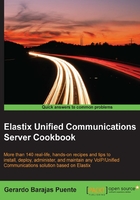
What this book covers
Chapter 1, Installing Elastix, covers basic recipes for installing Elastix.
Chapter 2, Basic PBX Configuration, demonstrates the processes for creating extensions, configuring telephony cards, setting an IVR, and controlling incoming and outgoing calls in a simple way.
Chapter 3, Understanding Inbound Call Control, explains how to get deeper into the IP-PBX features to give the installed solution.
Chapter 4, Knowing Internal PBX Options and Configurations, contains recipes used to configure the language of the recordings (or phrases) the Elastix Unified Communications Server displays, create conference bridges, restrict calls, add miscellaneous destinations and applications, and so on.
Chapter 5, Setting up the E-mail Service, assists you to set up the Elastix Unified Communications Server as an e-mail server.
Chapter 6, Elastix Fax System, explains that although the use of faxes is decreasing, there are situations (especially in communication with banks or government offices) in which it is necessary to send and receive faxes. This chapter is dedicated to this feature.
Chapter 7, Using the Call Center Module, shows one of Palo Santo's best contributions to the world of open source telephony, which is an open source call center module. In this chapter, you will be guided through the process of installing and configuring this feature.
Chapter 8, Going Deeper into Unified Communications, tells you how you can learn more about Unified Communications. This chapter includes recipes for configuring instant messaging, integration with a CRM and Outlook, video calls, and so on.
Chapter 9, Networking with Elastix, proves that one of Elastix's strengths is connecting remote sites and extensions by integrating the dialplan.
Chapter 10, Knowing the State of Your Elastix System and Troubleshooting, tells us when debugging and troubleshooting any situation in our system is necessary. The topics of billing and reporting are also discussed.
Chapter 11, Securing Your Elastix System, shows us that any IP device the Elastix Unified Communications Server can be targeted to be attacked in many ways, from denial-of-service attacks to telephone frauds, and when creating a backup of our solution, this chapter is helpful.
Chapter 12, Implementing Advanced Dialplan Functions, shows advanced features that are not included by default in our Elastix system and are very attractive to some enterprise levels, such as an IVR that retrieves information from a database.
Finally, we will discuss some important topics in the appendices, as follows:
Appendix A, Description and Use of the Most Well-known Free-PBX Modules, tells us about the contributions of third-party modules to the FreePBX community.
Appendix B, Addon Market Module, covers more of the programs certified by Palo Santo Solutions.
Appendix C, Asterisk Essential Commands, shows the most used commands available in Asterisk's command-line interface.
Appendix D, Asterisk Gateway Interface Programming, gives more in-depth information on the commands and information passed between Asterisk and any AGI.
Appendix E, Helpful Linux Commands, lists the most used Linux Commands for managing an Elastix Unified Communications system.